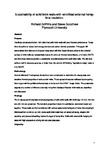Sustainability of solid brick walls with retrofitted external hemp-lime insulation
| dc.contributor.author | Griffiths, R | |
| dc.contributor.author | Goodhew, Steve | |
| dc.date.accessioned | 2017-05-17T15:40:58Z | |
| dc.date.available | 2017-05-17T15:40:58Z | |
| dc.date.issued | 2012 | |
| dc.identifier.issn | 0263-080X | |
| dc.identifier.issn | 1758-6844 | |
| dc.identifier.uri | http://hdl.handle.net/10026.1/9277 | |
| dc.description.abstract |
<jats:sec><jats:title content-type="abstract-heading">Purpose</jats:title><jats:p>Dwellings constructed before 1920 often had solid brick walls with poor thermal performance. Today there is a drive to reduce both energy demand and carbon dioxide production. The purpose of this paper is to demonstrate that mixtures of chopped hemp straw with lime based binders added to the external surface of brick walls can substantially reduce the air to air thermal transmittance, or <jats:italic>U</jats:italic>‐value W/m<jats:sup>2</jats:sup> K, and that these mixtures provide a sustainable remedial treatment for solid brick walls. The aim is to achieve wall <jats:italic>U</jats:italic>‐values as good as, or better than, the current UK Building Regulations design value of 0.30 W/m<jats:sup>2</jats:sup> K.</jats:p></jats:sec><jats:sec><jats:title content-type="abstract-heading">Design/methodology/approach</jats:title><jats:p>Several Microsoft Excel spread sheets have been constructed to determine the steady state and transient thermal properties of various brick walls. These spread sheets are validated by comparing their output with the published thermal data to be found in the CIBSE Design Guide. The sustainable aspects of a number of different externally hemp‐lime insulated Victorian brick walls are described and discussed.</jats:p></jats:sec><jats:sec><jats:title content-type="abstract-heading">Findings</jats:title><jats:p>The <jats:italic>U</jats:italic>‐values and the transient thermal properties of solid brick walls with thickness 110 mm, 220 mm and 340 mm are presented. The transient properties include the admittance, decrement factor and lag time. These walls are then considered with various added external layers of hemp‐lime ranging in thickness from 50 mm to 300 mm. Some solid brick walls have an added air cavity, created with studding and plywood sheathing, before the layer of hemp‐lime. Walls with external tile hanging for sites with high exposure to driving rain are also discussed.</jats:p></jats:sec><jats:sec><jats:title content-type="abstract-heading">Originality/value</jats:title><jats:p>The paper demonstrates the advantages of the energy saving and carbon dioxide sequestration achieved by adding 200 mm of a hemp‐lime binder insulation to the exterior of Victorian brick walls of terraced dwellings.</jats:p></jats:sec> | |
| dc.format.extent | 312-332 | |
| dc.language | en | |
| dc.language.iso | en | |
| dc.publisher | Emerald | |
| dc.subject | 11 Sustainable Cities and Communities | |
| dc.title | Sustainability of solid brick walls with retrofitted external hemp-lime insulation | |
| dc.type | journal-article | |
| dc.type | Article | |
| plymouth.issue | 4 | |
| plymouth.volume | 30 | |
| plymouth.publication-status | Published | |
| plymouth.journal | Structural Survey | |
| dc.identifier.doi | 10.1108/02630801211256661 | |
| plymouth.organisational-group | /Plymouth | |
| plymouth.organisational-group | /Plymouth/Faculty of Arts, Humanities and Business | |
| plymouth.organisational-group | /Plymouth/Faculty of Arts, Humanities and Business/School of Art, Design and Architecture | |
| plymouth.organisational-group | /Plymouth/REF 2021 Researchers by UoA | |
| plymouth.organisational-group | /Plymouth/REF 2021 Researchers by UoA/UoA13 Architecture, Built Environment and Planning | |
| plymouth.organisational-group | /Plymouth/Users by role | |
| plymouth.organisational-group | /Plymouth/Users by role/Academics | |
| dc.identifier.eissn | 1758-6844 | |
| dc.rights.embargoperiod | Not known | |
| rioxxterms.versionofrecord | 10.1108/02630801211256661 | |
| rioxxterms.licenseref.uri | http://www.rioxx.net/licenses/all-rights-reserved | |
| rioxxterms.type | Journal Article/Review |


